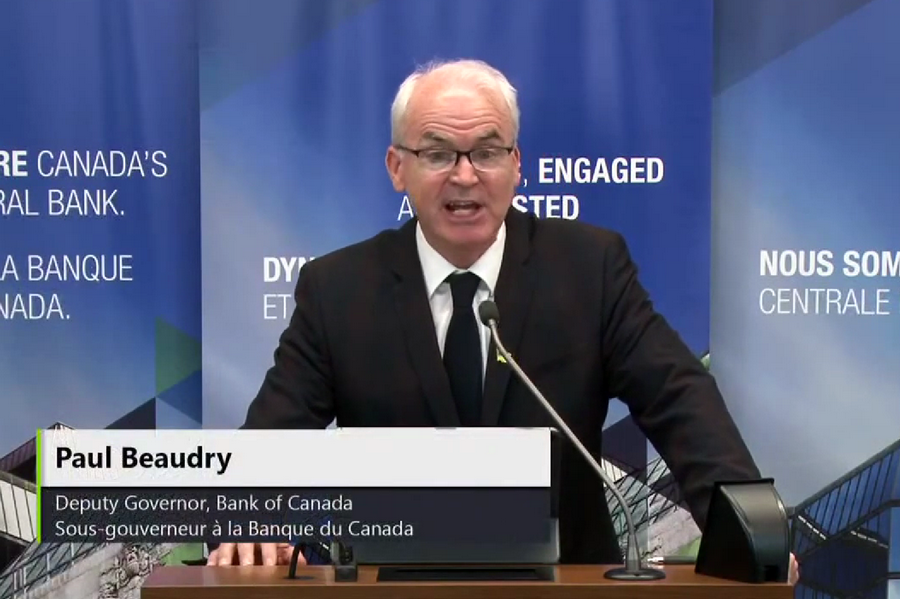

 OTTAWA – The Bank of Canada may need to raise its key interest rate to three per cent or beyond – more than double its current level – to ensure inflation doesn’t settle in for the long haul, its deputy governor says.
OTTAWA – The Bank of Canada may need to raise its key interest rate to three per cent or beyond – more than double its current level – to ensure inflation doesn’t settle in for the long haul, its deputy governor says.
“We’re scared that this inflation becomes entrenched,” Paul Beaudry told reporters Thursday afternoon, while assuring Canadians the institution would prevent it.
In an earlier speech to the Gatineau Chamber of Commerce, he said the likelihood of even higher consumer prices on the horizon means the central bank will consider pushing its policy rate at least to the top end of its “neutral” range – between two and three per cent, which neither spurs nor hampers growth.
The rate has sat below two per cent since 2008, driven down by the housing crash that kicked off the Great Recession.
“Price pressures are broadening and inflation is much higher than we expected and likely to go higher still before easing,” Beaudry said in French Thursday morning.
“This raises the likelihood that we may need to raise the policy rate to the top end or above the neutral range to bring demand and supply into balance and keep inflation expectations well anchored.”
The annual pace of inflation rose to 6.8 per cent in April, the fastest year-over-year rise in 31 years as the price of goods from gas to groceries continued to climb.
The groundwork for more oversized hikes comes after the Bank of Canada on Wednesday raised its benchmark rate, bringing it to 1.5 per cent. The move marked the first back-to-back half-point hikes since scheduled rate announcements began in 2000. In April, the bank increased the rate by half a percentage point to one per cent.
Supply chain disruptions during the pandemic lasted longer than the central bank anticipated, exacerbated by unexpected events like Russia’s invasion of Ukraine and COVID-19 lockdowns in China, Beaudry said.
He said some Canadians feel inflation is already feeding on itself, driven by expectations of even costlier goods and services as wages rise to meet mounting prices in a self-reinforcing cycle. But he maintained that pandemic-related supply issues are the main driver of eye-popping price tags and that higher rates will bring down demand relative to supply, easing inflationary pressures.
The bank makes changes to its trendsetting interest rate in an effort to control inflation with a target of two per cent. Rate hikes aim to cool borrowing and spending by boosting the cost of loans linked to the benchmark, including variable-rate mortgages.
“The longer inflation remains well above our target, the more likely it is to feed into inflation expectations, and the greater the risk that inflation becomes self-fulfilling,” Beaudry said.
“History shows that once high inflation is entrenched, bringing it back down without severely hampering the economy is hard.”
Central banks across the globe were “caught flat-footed” amid an unprecedented situation, failing to foresee how quickly consumer spending would roar back after the pandemic’s early days and then how persistent the supply chain backlogs would prove, Bank of Montreal chief economist Douglas Porter said in an interview.
“This is the bank moving with a lot of pace to try to cut inflation off at the pass,” he said of Wednesday’s rate hike – and the promise of more to come.
Crimped global supply chains and higher prices on goods from electronics to wheat along with historically low unemployment at home will likely push inflation well past the bank’s previously projected rate of nearly six per cent for the first half of the year, it said Wednesday.
Domestically, spend-happy households and businesses are also overheating the economy, Beaudry said, though signs of fallout from three interest rate hikes in four months are already visible, particularly in the housing market.
Home sales dropped 12.6 per cent in April from March, and sat more than one-quarter below sales figures from April 2021, according to the Canadian Real Estate Association. The home price index dipped 0.6 per cent month over month.
“We think we can kind of rein this in without necessarily getting into a recession-type area,” Beaudry told reporters.
Optimism around inflation is not so broad. A March survey from the Canadian Federation of Independent Business found that small business owners expected to jack up prices 4.7 per cent on average in 12 months.
“That’s really what’s worrying us,” Beaudry said, referring to one-to-two-year inflation expectations. “The good part is, looking further out – five years out – people have confidence that we will bring it back.”
The bank is also easing pandemic-era stimulus measures by continuing so-called quantitative tightening, launched in April, as the government bonds it holds are no longer being replaced when they mature.
Asked whether Pierre Poilievre, widely seen as the frontrunner in the federal Conservative leadership race, was fair in demanding Bank of Canada governor Tiff Macklem be fired for acting as the Liberal government’s “ATM,” Beaudry replied: “No … We’re not in the business of politics.
“We haven’t managed to keep inflation at our target, so it’s appropriate that people are asking us questions,” he added.
The bank expects its holdings of Canadian government bonds, which sat at $440 billion at the end of last year, to fall to $280 billion by the end of 2023, a 35 per cent drop over two years.
Bank of Canada increases policy interest rate by 50 basis points, continues QT
The Bank of Canada hiked rates again. Here’s a timeline of how we got here
Bank of Canada on track for rate hike after GDP growth slows: Economists
This report by The Canadian Press was first published June 2, 2022.